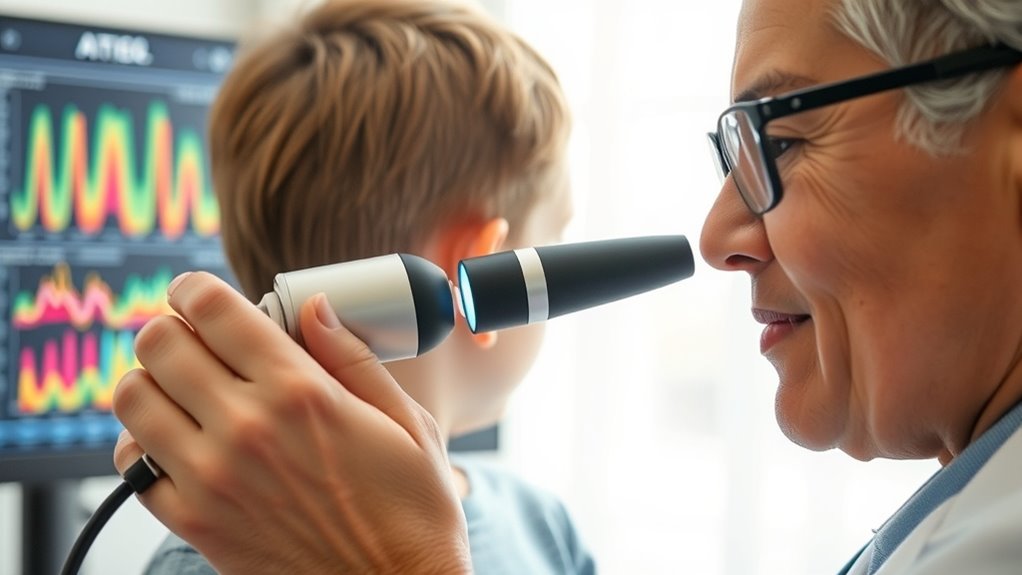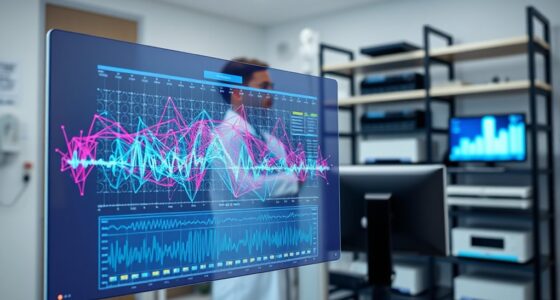AI is revolutionizing how doctors spot hearing loss early by providing more precise, quick, and objective assessments. Traditional tests can be limited by noise, subjectivity, and environments that aren’t always ideal. AI-driven tools analyze complex patterns in hearing data, enabling faster diagnosis and earlier intervention. This technology helps identify subtle signs of hearing decline sooner, improving treatment outcomes. Keep exploring to learn how these advances are shaping better hearing health for you.
Key Takeaways
- AI analyzes subtle auditory patterns for early hearing loss indicators, often before traditional methods detect them.
- Machine learning enhances diagnostic accuracy, enabling quicker and more reliable early detection.
- AI-powered tools reduce reliance on subjective responses, improving assessment consistency across populations.
- Real-time AI analysis facilitates faster screening, allowing timely intervention and treatment planning.
- Integration of AI with advanced sensors and data fusion broadens access to early hearing loss detection.
The Importance of Early Hearing Loss Detection

Early detection of hearing loss is crucial because it allows for timely intervention that can greatly improve your quality of life. Genetic predispositions can make you more susceptible to hearing issues, especially if there’s a family history. Recognizing these inherited risks early helps you take preventive steps or seek treatment sooner. Environmental impacts, such as exposure to loud noises or ototoxic substances, also play a significant role in hearing health. The sooner you identify hearing loss, the better your chances of minimizing long-term damage. Proper maintenance and awareness can help preserve your hearing and prevent avoidable loss. Advances in AI-powered diagnostics enable earlier and more accurate detection of hearing issues, offering new hope for timely treatment. Integrating advanced imaging technologies can further enhance diagnostic precision, leading to better outcomes. Additionally, automation in health monitoring can facilitate continuous hearing health assessments outside clinical settings. Early detection ensures you can access effective treatments, like hearing aids or therapy, before the condition worsens. Recognizing the role of genetics in hearing loss helps individuals understand their risk factors better and seek early screening. By understanding your genetic and environmental risks, you can actively protect your hearing and maintain better communication and overall well-being.
Traditional Methods for Hearing Screening

Traditional hearing screening methods have long served as the first line of defense in detecting hearing loss. You typically start with a simple hearing test, where an audiologist performs audiogram interpretation to assess your hearing thresholds across different frequencies. This helps identify the severity and type of hearing loss. If needed, a hearing aid fitting is then recommended to improve your hearing. These tests are usually quick and non-invasive, relying on tones or speech stimuli to gauge your responses. While effective for initial screening, they often require specialized equipment and trained professionals. These methods have been the standard for decades, providing essential information for diagnosis and treatment planning but sometimes missing early signs of hearing decline that could benefit from more advanced detection techniques. Additionally, emerging AI-based detection technologies hold promise for earlier and more precise identification of hearing issues. Early detection methods can help prevent further deterioration and improve patient outcomes.
Limitations of Conventional Diagnostic Techniques

While conventional diagnostic techniques like audiograms are valuable, they have notable limitations in detecting hearing loss at its earliest stages. Noise interference during testing can distort results, making it harder to identify subtle issues. Additionally, these methods rely heavily on subjective assessments, where your responses influence the diagnosis. This subjectivity can lead to inconsistent results, especially with young children or individuals unsure of their hearing ability. Conventional tests often require a quiet environment and active participation, which isn’t always feasible. As a result, early signs of hearing loss may go unnoticed until more significant problems develop. These limitations highlight the need for more precise, objective tools that can detect hearing issues sooner and with greater accuracy. Essential oils for early detection offer a novel approach by potentially providing more consistent and early indicators of auditory health issues.
How Artificial Intelligence Enhances Hearing Assessments

Artificial intelligence improves hearing assessments by providing more accurate diagnostics, so you get reliable results faster. It streamlines the evaluation process, reducing wait times and helping doctors make quicker decisions. With AI, early detection becomes more precise and efficient, benefiting your overall hearing health. Additionally, integrating advanced screening techniques ensures that even subtle hearing issues are identified promptly. Implementing air purifier technology can help create healthier environments that support better hearing outcomes. Developing a professional demo reel can also enhance a clinician’s ability to interpret AI-generated data effectively. As automation continues to evolve in healthcare, it supports better patient outcomes through hybrid/combination units, which combine multiple methods for comprehensive assessments.
Accurate Hearing Diagnostics
Artificial intelligence is revolutionizing hearing assessments by enabling more accurate diagnostics. With AI-powered tools, you can obtain precise measurements of your hearing capabilities, leading to better diagnosis and personalized treatment plans. These advancements drive hearing device innovation, allowing devices to adapt more effectively to individual needs. AI algorithms analyze complex data sets quickly, reducing errors and providing clearer insights into hearing loss severity. This technology also emphasizes the importance of subconscious perception in understanding and addressing hearing health, thereby enhancing diagnostic outcomes. This not only improves diagnostic accuracy but also enhances patient engagement, as you become more involved in understanding your condition. When assessments are more accurate, your healthcare provider can recommend optimal solutions sooner, improving outcomes. Overall, AI empowers both clinicians and patients, making hearing diagnostics more reliable and tailored to your unique hearing profile.
Rapid Assessment Processes
Thanks to AI, hearing assessments now happen much faster and more efficiently. AI-powered tools streamline processes like sound localization, helping doctors quickly identify where sounds originate. This accelerates diagnosis, especially for patients who might struggle with traditional testing methods. For those with cochlear implants, AI can rapidly evaluate how well they perceive sound, guiding adjustments and improvements. Automated analysis reduces the time needed for extensive assessments, enabling quicker treatment decisions. AI also detects subtle patterns that human testers might miss, ensuring no detail is overlooked. Additionally, integrating performance tuning concepts from Mazda vehicle modifications can inspire more precise calibration of hearing devices, further enhancing outcomes. Incorporating advanced GMC tuning techniques can optimize device performance and patient comfort. Furthermore, the use of artificial intelligence in hearing assessments enhances the ability to identify issues at earlier stages, facilitating timely interventions. AI-driven diagnostic accuracy improves early detection, leading to better treatment planning. The integration of healthcare resources can also support more comprehensive patient care. Overall, these rapid assessment processes improve accuracy and patient outcomes, making early detection of hearing issues more accessible and effective. This innovation transforms how healthcare providers evaluate and treat hearing loss, especially in complex cases.
Data Analysis and Pattern Recognition in AI Tools
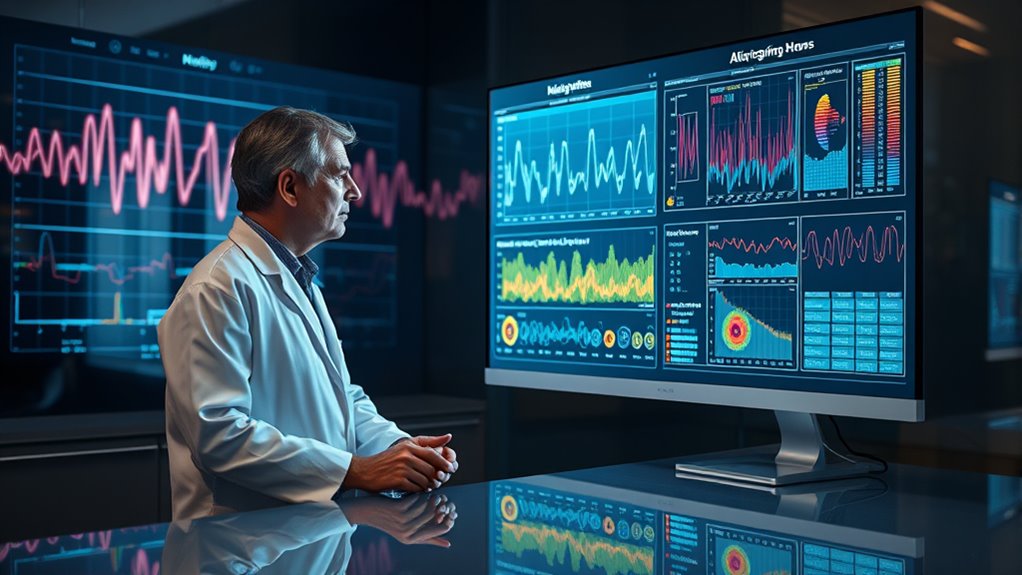
Data analysis and pattern recognition are at the heart of AI tools used in hearing loss detection, enabling doctors to identify subtle signs that might otherwise go unnoticed. Neural networks play a vital role by mimicking the brain’s ability to learn from vast amounts of data, allowing the system to recognize complex auditory patterns. Data mining techniques help sift through large datasets, uncovering hidden correlations and trends related to hearing health. These AI-driven methods improve diagnostic accuracy by revealing early indicators of hearing loss, even when symptoms are mild or ambiguous. Incorporating visionary insights can inspire innovative approaches to audiology, pushing the boundaries of early detection. Additionally, understanding the subtle auditory cues that indicate hearing issues can further refine AI models for more precise diagnostics. As a result, you can catch issues sooner, leading to more timely interventions and better patient outcomes. This sophisticated pattern recognition is transforming audiology by making detection more precise and proactive.
AI-Driven Diagnostics in Audiology Practices

AI-driven diagnostics are transforming audiology practices by providing faster, more accurate assessments of hearing health. Machine learning algorithms analyze complex hearing data, identifying subtle patterns that might escape traditional methods. This enables you to detect hearing loss earlier and tailor interventions more effectively. Data visualization tools further enhance your understanding by presenting results clearly and intuitively, helping you interpret diagnostic insights quickly. These visualizations make it easier to spot anomalies and track changes over time, improving your decision-making process. Additionally, understanding angel number meanings can offer spiritual insights into personal relationships and life paths. Incorporating advanced data analysis techniques can further improve diagnostic accuracy and patient care. As a result, you can offer more personalized care, reduce diagnostic errors, and streamline your workflow. Integrating AI diagnostics into your practice empowers you to deliver precise, timely evaluations, ultimately improving patient outcomes and advancing audiological care.
Benefits of Using AI for Hearing Loss Identification

Using AI to identify hearing loss offers numerous advantages that can markedly enhance patient care. Machine learning algorithms quickly analyze complex audiometric data, enabling earlier detection than traditional methods. This means you can intervene sooner, improving outcomes. Additionally, AI systems are designed with data privacy in mind, ensuring patient information stays secure while still providing accurate results. The table below highlights key benefits:
| Benefit | Explanation | Impact |
|---|---|---|
| Faster diagnosis | Quickly processes large datasets | Quicker treatment decisions |
| Improved accuracy | Reduces human error | More reliable results |
| Data privacy | Maintains strict confidentiality | Builds patient trust |
| Personalized care | Tailors interventions based on individual data | Better patient outcomes |
| Cost efficiency | Reduces need for repeated testing | Saves resources |
Implementing advanced data analysis techniques further enhances the precision of early detection, leading to more effective management strategies. The integration of machine learning models enables continuous improvement in diagnostic capabilities. Moreover, ongoing research continues to expand AI capabilities, promising even more sophisticated diagnostic tools in the near future.
Case Studies Demonstrating AI Effectiveness
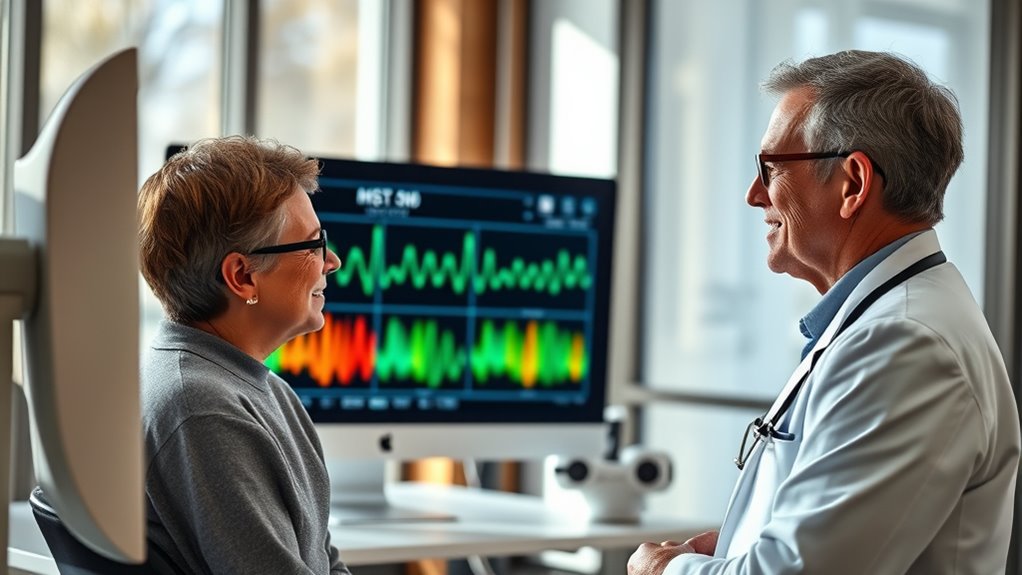
Real-world examples show just how effective AI can be in detecting hearing loss early. For instance, clinics using AI models identified subtle auditory changes that traditional tests missed, leading to earlier interventions. One case highlighted AI’s ability to adapt to diverse populations, but it also revealed issues with AI bias, risking unequal detection rates. Ethical concerns arise when algorithms lack transparency or inadvertently reinforce disparities. To guarantee AI’s benefits outweigh risks, developers must address:
- Bias mitigation techniques to prevent skewed results
- Transparent algorithms to build trust
- Inclusive datasets that reflect diverse patient populations
These case studies demonstrate AI’s potential but also remind us to remain vigilant about ethical challenges, ensuring technology benefits all patients equally.
Future Developments in AI-Powered Hearing Screening
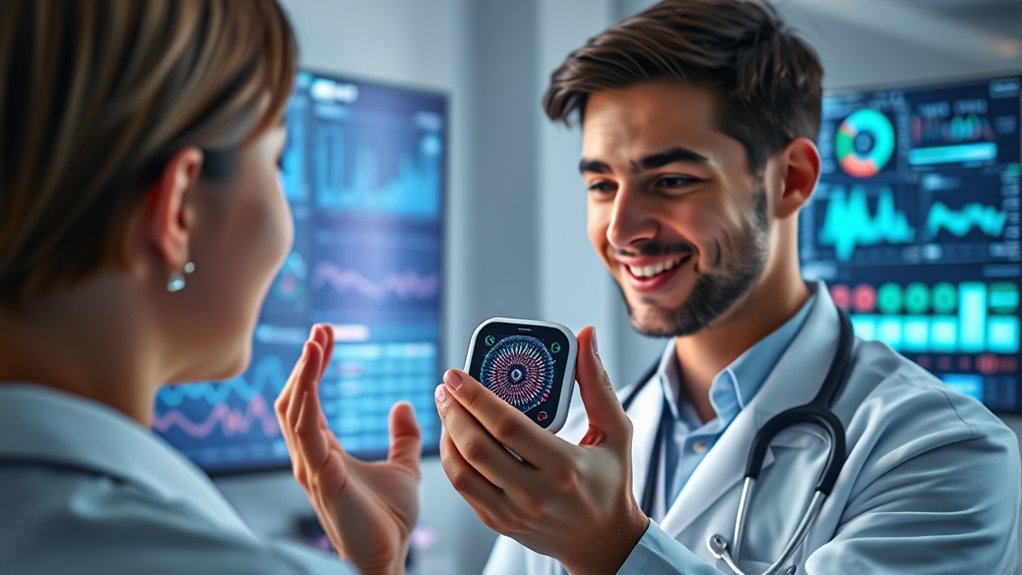
As technology advances, future developments in AI-powered hearing screening promise to make early detection even more accurate and accessible. Sensor fusion techniques will combine data from multiple sensors, providing a thorough view of hearing health. Neural networks will become more sophisticated, improving pattern recognition and diagnosis accuracy. These advancements will enable real-time analysis, reducing wait times and increasing screening reach. Imagine a table like this:
| Technology | Benefit | Impact |
|---|---|---|
| Sensor Fusion | Integrates multiple data sources | More precise detection |
| Neural Networks | Learns complex patterns | Improved accuracy |
| Portable Devices | Easy access in clinics & homes | Widespread screening |
You’ll see faster, smarter screenings that catch hearing loss early, even before symptoms appear.
Integrating AI Into Routine Hearing Healthcare

Integrating AI into routine hearing healthcare is transforming how you diagnose and manage hearing loss. Machine learning algorithms analyze patient data quickly, enabling accurate, early detection. These systems enhance your ability to identify subtle patterns that might otherwise go unnoticed. Data visualization tools present complex information clearly, helping you interpret results efficiently. By incorporating AI, you can:
- Streamline screening processes and reduce wait times
- Personalize treatment plans based on detailed data insights
- Improve patient outcomes through early intervention
This integration empowers you to make informed decisions faster, ensuring patients receive timely care. As AI becomes a standard part of your practice, you’ll enhance diagnostic precision and optimize hearing health management, ultimately benefiting your patients’ quality of life.
Frequently Asked Questions
How Accurate Are AI Tools Compared to Traditional Hearing Tests?
You might wonder how AI tools compare to traditional hearing tests. Generally, AI algorithms show high accuracy, with some studies indicating they surpass traditional methods in diagnostic reliability. Their algorithm accuracy improves with more data, allowing for quicker, more precise assessments. While not perfect yet, AI is becoming a valuable supplement, providing consistent results and aiding in early detection of hearing issues, ultimately helping you get timely treatment.
What Are the Privacy Concerns Associated With Ai-Based Hearing Diagnostics?
When it comes to AI-based hearing diagnostics, you should be aware of data privacy and ethical considerations. Your personal health data needs to be securely stored and handled responsibly to prevent misuse or breaches. Developers must follow strict privacy regulations, and transparency about how data is used is essential. By addressing these concerns, you can trust that your sensitive information remains protected while benefiting from innovative hearing health solutions.
Can AI Detect Specific Types of Hearing Loss More Effectively?
You can rely on AI to detect specific types of hearing loss more effectively by analyzing genetic markers and environmental factors. AI systems process vast data to identify patterns that distinguish different hearing impairments, enabling precise diagnoses. This targeted approach helps you get personalized treatment plans faster and more accurately, ultimately improving your hearing health outcomes through early and specific intervention.
How Accessible Are Ai-Driven Hearing Screening Technologies Globally?
You might wonder about the accessibility of AI-driven hearing screening globally. While these technologies are advancing, global disparities remain due to differences in healthcare infrastructure. In many regions, technology affordability constrains access, making it harder for underserved populations to benefit. Efforts are underway to develop cost-effective solutions, but bridging the gap requires ongoing investment and innovation to ensure everyone can access early hearing loss detection.
What Training Is Required for Clinicians to Implement AI in Audiology?
To implement AI in audiology, you need proper training and certification to guarantee clinical integration. You should learn how to interpret AI-generated data accurately and understand its limitations. Clinicians often undergo specialized courses or workshops focusing on AI tools, data security, and patient privacy. Certified training programs help you confidently incorporate AI into your practice, making the technology an effective part of early hearing loss detection and overall patient care.
Conclusion
So, next time you ignore that tiny ringing in your ears, remember—AI might just catch your hearing loss before you even notice it. Who knew that robots could be the heroes of your hearing health, saving you from the embarrassment of asking others to repeat themselves? Embrace the future, because if AI can spot your hearing issues early, maybe you should start trusting its judgment—before it starts diagnosing your coffee addiction too.

